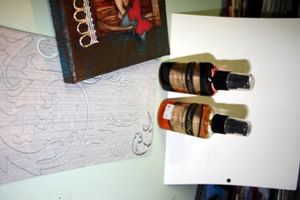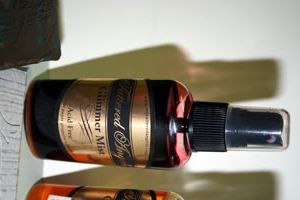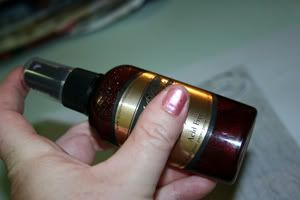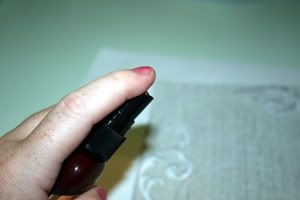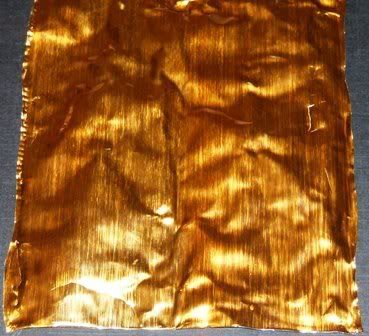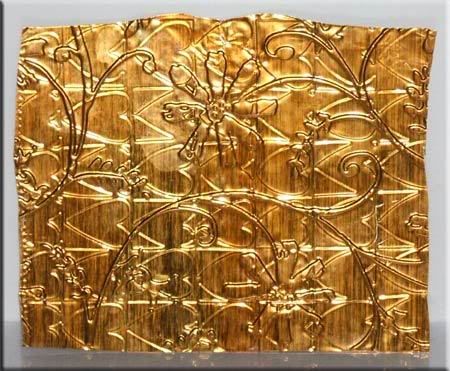Here are the items I used:
- Back of a mouse mat
- Scrap of printer paper
- PVA glue
- Teaspoon
- Pencil
- Coloured Pencil
- Darning Needle
- Scissors
Cut three strips of paper approx. 17cmx3cm (6.5"x1.25"). They don't need to be perfect - just roughly cut. Fold each piece in half down its length as with the left hand piece here.
Cut out a half petal shape from the creased side. My petal is about 3.5cm (1.25") long.
Take your cut out petal and move it up the piece of folded paper and place it against the crease as shown. Hold in place whilst you use it as a template to cut out the next petal. This is to help get the petals approximately the same. Repeat this until you have cut out 12 petals altogether. Make sure that you use the first petal that you cut each time as your template. Otherwise your petals might get larger and larger as you go along.
I hold the petal and folded paper like this in my right hand and tap them on the table to quickly align the creases. It's then quick and easy to transfer to being held in my left hand on the crease, so that I can cut. I don't put the scissors down between each cut as this also is quicker.

Now cut out two rough little circles. These are about 1.5cm (0.5") in diameter. You are allowed to use a circle punch if you have one, but I am sticking to my promise of no specialist tools! To cut these circles I folded a small square in quarters and then cut a quarter circle shape at the corner where all the creases meet. Put a little pencil dot at the centre.

Place a small blob of glue on a scrap of paper. Touch the tip of the petal to the blob - you are only aiming to get a tiny spot on the petal tip.

Stick the tip of the petal about halfway between the pencil dot and the edge of the circle. Stick another petal opposite as shown. Then stick four more petals on the circle - spacing them out evenly between the first two.

Repeat with the second circle and remaining 6 petals so that you have two flower layers like this.
Placing the arrangement on a scrap of paper to protect your desk top, draw lines with the coloured pencil from the inner tip of the petal towards the outer tip. Just over half way looks good - but it is a matter of preference. Make the lines fan out slightly and draw each one with a quick flicking sort of movement - gives better results as the end of the line tapers out with this movement. Don't try and be too neat and even. The length of the lines needs to vary a little. Hold the flower steady with your finger in the centre just on the base of the petal you are working on.
Here are the two layers with their completed lines. Set them aside for the glue to dry completely. This is important for the shaping later on. You cannot shape wet paper.

Whilst the flower layers are drying, make the centre. To do this, cut narrow strip of paper about 20cm (8") long and roughly 0.75cm (0.25") wide. Colour in both sides of the strip with the coloured pencil. As you can see - only rough colouring is required. Then cut a fringe along one long edge across about half the width of the strip. How fine a fringe is up to you and your patience to cut it! My cuts are a couple of mm/sixteenth of an inch apart.

Take your darning needle and starting with the very end of the strip roll the paper around the needle. Start off by winding tightly, but once it's going you can loosen up a bit as you are aiming for a slightly scruffy loose-ish roll. It can be tricky to get it going - so patience is required!

When the whole length is rolled up, slide the paper off the needle and make sure that it is a fairly open coil. Then put a tiny spot of pva on the end and stick it down - hold for a few moments whilst it sets enough to let go without it popping off.

Here is a view from the top of the finished coil to show what you are aiming for.

Place the coil flat on the table, with the cut edges uppermost. Place your thumb in the centre to steady it, and use the end of the teaspoon handle to spread the fringes out and down. Keep going round and round, pulling more out from the centre as you go.

It will look a bit like this when it's all fanned out. Set it aside.

Now take your teaspoon and hold it like this. The important thing is that the handle has to have a completely straight edge, and be a flat, thin handle. If you don't have this shape of handle, then try a thin cross head screwdriver. Get a good firm grip with the bowl of the spoon held in your hand, and your index finger on the edge of the handle.

Top view of the grip. Also shows what I mean about a flat, thin handle.

Place your mouse mat at the edge of the table, and the flower near the edge of the mat. Hold the spoon handle at right angles to the surface - so that the edge of it only is in contact - and the length of it is parallel to the centre crease of one of the petals, and at the right hand edge of it. (If you are left handed you will need to start at the left edge of the petal. The entire thin edge of the handle must be flat on the petal/mat - which is why the mat needs to be at the edge of the table - to make room for your hand below the table top level.

Now the motion you are going to make is like spreading butter. Move the handle across the petal from one side to the other, keeping it parallel with the centre crease the whole time. Apply a bit of downwards pressure. Takes a bit of practice, but is easy and quick once you get the hang of it. Steady the flower with your other hand (mine is on the camera, but would normally be on the petal). As you move the handle across, the petal will curl up behind it. The more pressure you use, the more the petal will curl. If it curls too much, then gently push the edges back down a bit with your fingers. If it does not curl enough, go back over it with the spoon handle with slightly more pressure.
Curl all the petals in the same way, turning the flower each time so that you bring the petal you are working on into the same spot to get a convenient angle to use the spoon handle.

Here are both flowers with all the petals curled.

If your pencil has a 'wrong' end that is smooth and rounded like this one, it is ideal for embossing. If not, then try the wrong end of a Bic type pen, or a gel pen cap. Place it at the base of one of the petals. Now press a little, and draw an imaginary circle around the base of all the petals. Go round two or three times. Again, the harder you press the more the petals will pop up. If they pop up more than you like, then gently spread them back down again with your fingers. If less, then go around again with slightly more pressure. Do this on both layers.

Side view to show the petals popped up.

Place a tiny spot of glue in the centre of one of your layers. Place the other layer on top, arranging it so that the petals fall in the gaps of the one below. Make sure that it is reasonably centred, and then press down in the middle to stick firmly. With the pva you do have a few moments working time to adjust the position.

With the two layers stuck together, spread a thin layer of glue in a circle in the middle of the top layer. Place your fringed flower middle on top of the glue, and when you are happy with its position, press it down to secure. At this stage you can rearrange the fringing if you need/want to improve its appearance.

Ta -da!! One 'No Tools Flower'.

You can of course cut your petals in different shapes. Here is a flower I made by cutting a rounded top petal. I used paper from an envelope that I received in the mail the other day, and brushed the outer edges of the petals and the fringed centre with a gold ink pad. Sorry the picture's not too good - by the time I had finished this flower, I had run out of decent daylight to take the picture. But at least you can see the general idea.
A note from Julie:~ Another fantastic flower tutorial from Joanne and isn't the final card stunning!
I am pleased to say that Joanne is a regular contributor to this blog so keep checking back for more brilliant Tutorials from her.
Go and check out Joanne's fantastic 'Mainly Flowers' Blog HERE






